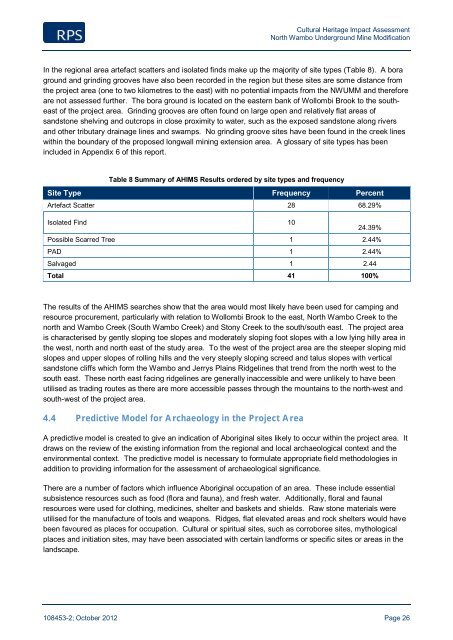Appendix C - Cultural Heritage Impact Assessment - Peabody Energy
Appendix C - Cultural Heritage Impact Assessment - Peabody Energy
Appendix C - Cultural Heritage Impact Assessment - Peabody Energy
You also want an ePaper? Increase the reach of your titles
YUMPU automatically turns print PDFs into web optimized ePapers that Google loves.
<strong>Cultural</strong> <strong>Heritage</strong> <strong>Impact</strong> <strong>Assessment</strong><br />
North Wambo Underground Mine Modification<br />
In the regional area artefact scatters and isolated finds make up the majority of site types (Table 8). A bora<br />
ground and grinding grooves have also been recorded in the region but these sites are some distance from<br />
the project area (one to two kilometres to the east) with no potential impacts from the NWUMM and therefore<br />
are not assessed further. The bora ground is located on the eastern bank of Wollombi Brook to the southeast<br />
of the project area. Grinding grooves are often found on large open and relatively flat areas of<br />
sandstone shelving and outcrops in close proximity to water, such as the exposed sandstone along rivers<br />
and other tributary drainage lines and swamps. No grinding groove sites have been found in the creek lines<br />
within the boundary of the proposed longwall mining extension area. A glossary of site types has been<br />
included in <strong>Appendix</strong> 6 of this report.<br />
Table 8 Summary of AHIMS Results ordered by site types and frequency<br />
Site Type Frequency Percent<br />
Artefact Scatter 28 68.29%<br />
Isolated Find 10<br />
24.39%<br />
Possible Scarred Tree 1 2.44%<br />
PAD 1 2.44%<br />
Salvaged 1 2.44<br />
Total 41 100%<br />
The results of the AHIMS searches show that the area would most likely have been used for camping and<br />
resource procurement, particularly with relation to Wollombi Brook to the east, North Wambo Creek to the<br />
north and Wambo Creek (South Wambo Creek) and Stony Creek to the south/south east. The project area<br />
is characterised by gently sloping toe slopes and moderately sloping foot slopes with a low lying hilly area in<br />
the west, north and north east of the study area. To the west of the project area are the steeper sloping mid<br />
slopes and upper slopes of rolling hills and the very steeply sloping screed and talus slopes with vertical<br />
sandstone cliffs which form the Wambo and Jerrys Plains Ridgelines that trend from the north west to the<br />
south east. These north east facing ridgelines are generally inaccessible and were unlikely to have been<br />
utilised as trading routes as there are more accessible passes through the mountains to the north-west and<br />
south-west of the project area.<br />
4.4 Predictive Model for Archaeology in the Project Area<br />
A predictive model is created to give an indication of Aboriginal sites likely to occur within the project area. It<br />
draws on the review of the existing information from the regional and local archaeological context and the<br />
environmental context. The predictive model is necessary to formulate appropriate field methodologies in<br />
addition to providing information for the assessment of archaeological significance.<br />
There are a number of factors which influence Aboriginal occupation of an area. These include essential<br />
subsistence resources such as food (flora and fauna), and fresh water. Additionally, floral and faunal<br />
resources were used for clothing, medicines, shelter and baskets and shields. Raw stone materials were<br />
utilised for the manufacture of tools and weapons. Ridges, flat elevated areas and rock shelters would have<br />
been favoured as places for occupation. <strong>Cultural</strong> or spiritual sites, such as corroboree sites, mythological<br />
places and initiation sites, may have been associated with certain landforms or specific sites or areas in the<br />
landscape.<br />
108453-2; October 2012 Page 26

















